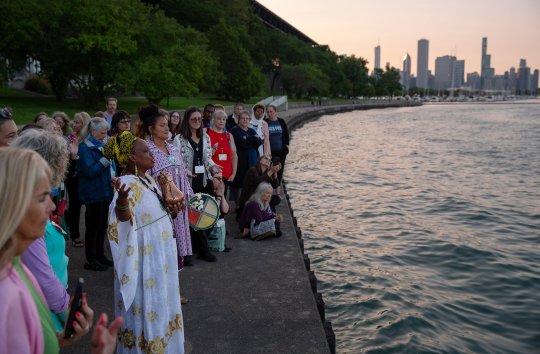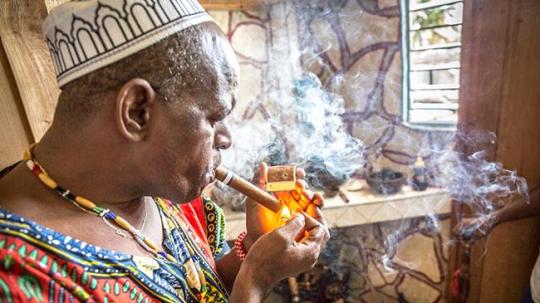#Yoruba people
Explore tagged Tumblr posts
Text
Yoruba Door Wood Carvings: The Artistic Tradition and Cultural Significance
The Yoruba door holds within its intricate wood carvings a rich tapestry of history and tradition, offering a fascinating glimpse into the cultural heritage of the Yoruba people. Crafted around 1910-1914, this remarkable piece of art is attributed to “The Master of Ikerre,” an enigmatic figure whose legacy is shrouded in mystery. Despite the uncertainty surrounding the carver’s identity, the…

View On WordPress
#African Art#African History#The Master of Ikerre#West African#West African history#Yoruba architecture#Yoruba door#Yoruba History#Yoruba people
2 notes
·
View notes
Text
Focusing on the Oyo Empire first in West Africa for specific reasons:
Out of the various African states in West Africa and the Sahel to receive more specific focuses, the Oyo Empire comes first for very specific reasons. Not least that it was the established power in the land when Usman Al Fodio built the Fulani Jihad to undermine it out of anger and envy that a proudly and defiantly infidel state had greater power than the Muslim majority around it. Second, that in contrast to the events of The Woman King in actual history it was Dahomey Amazons raiding their fellow pagans in Oyo for the slave trade rather than the other way around.
And of course in the other aspect because Yoruba people, of whom this was their major state, are a key component in the various religions of Voudoun, Santeria, and Candomble and their historical-cultural traditions are key to the African diaspora. Yoruba, Igbo, and Ashanti were among the groups most ravaged by the trade, and for this history 'rewarded' them by making the victims the villains with a straight face.
#lightdancer comments on history#black history month#military history#yoruba people#empire of oyo#dahomey amazons#the woman king#the woman king is a good film but as historical as that dinosaur movie with the four-legged Tyrannosaurus
0 notes
Text
I know about Genshin Impact's pretty infamous whitewashing but goddamn I didn't know they were whitewashing characters from my country/culture.

#txt#im igbo not yoruba but some of these people/gods overlap with my culture. actually crazy#first hazbin hotel now this game. please stop taking from black culture if all you want to do is whitewash it#overdesigned and racist pick a struggle man
965 notes
·
View notes
Text
the way that diff languages sound r so fascinating they're all different and all so vivid
#russian is like the surface of a feather like it's light but not exactly “soft” but still very delicate#german is . cute ? i think it's adorable . it has a lot of momentum it makes u wanna talk fast and talk a lot#like it's squishy . sleek surface w a soft inside#thai is like song . it's like interprative dance or maybe a trust-fall . everything follows from the previous thing#it feels like a little fairy flying up and letting itself fall and flying up again and so on (for fun). its so beautiful but also playful#mandarin chinese is like . idk why but it gives me the same vibe the concept of Observation does . like to read and to see and absorb#and then to translate that into smth else . like . imagine a poet people watching or an artist preparing a canvas w practiced hands. thats#the vibe. soft and elegant and musical but like...in a way that feels lived-in. arabic feels wise ? like music or poetry u read#and feel nothing about then years later u stumble on and it applies to everything in ur life. that kind of vibe. like it knows more than u#and itll make sure ur heart and soul grows as big as its lexicon . polish is like snowflakes falling . it has the feeling of complexity and#elegance but it's also so so light and slippery and...maybe not elusive but the feeling of losing a dance partner in a waltz ? like fun and#light but also an underlying elegance and somberness still . turkish is like the feeling when u get a text from ur crush#and your heart tightens and you cant tell if it's really painful or really amazing . it feels like unrequited love . or a caress#or making out with someone when you know its the last time you'll see them. its beautiful in a yearning longing way#korean is like joking around w ur friends and you've stayed up until like almost 5 AM and youre so delirious that everything is funny#and ur speaking kind of lightly and openly and everything you say holds a lot of weight and doesnt matter at all. you laugh at everything#and youre practically talking in inside jokes and watching the sunrise together . one of them hits u on the shoulder lovingly. ur by a fire#yoruba feels like the metatheory of the matatheory . abstraction until it circles back to intuition or maybe#it feels like plotting the route of a comet or maybe like the soft warm whirr of statistics. trying to verbalise beauty somehow#when you know the best thing you can show it is by telling everyone just look!! look at the sky just look!#anyway yh i think i could do this for every language ever tbh
51 notes
·
View notes
Text

August 15, 2023: Yoruba priestess Aina-Nia leads a water ceremony by Lake Michigan as part of the Parliament of the World's Religions in Chicago. During the ceremony, which recognized the sacredness of water, water from different parts of the world was combined and poured into the lake.
Photo by Lauren Pond
#religion#yoruba#priestess#people#holy water#parliament of the world's religions#united states#divinum-pacis#interfaith
157 notes
·
View notes
Text
Yoruba Proverb
If a house is progressing it’s because the bastard of the house hasn’t grown up. – Yoruba proverb
4 notes
·
View notes
Text

Do you know how to pray the Mojubá? Do you know how to pray in the morning? To greet the new day that arrives, asking for the blessing of your mother, father, mother of saint, of your ancestors, etc? It's important for us to have a repertoire of our own prayers, our people don't need to keep repeating the catechesis, for our Ancestors it was a mandatory act of colonization [...] I’m going to do a little bit of Ibase for you to add to your repertoire [...] so you can draw upon your own tradition. "I salute Olodumare, Lord of the day, I salute the East, I salute the West, I salute the North, I salute the South, I salute the Ancestors, I salute my Father, I salute my Mother, I salute my Father of Saint, I salute my Mother of Saint, I salute my Eldest Guide, I salute my Community, I salute my Head (Orí, Crown), I salute Oshún sengese oloya hun, I salute Yemoya Lady of the River Ogun, I salute Ogum Lord of the Universe, I salute Oya Oriri, I salute Exú lalu ogiri oko, I salute Xangó the one who bears the crown, I salute all Orixás, every single one of them, to them I give my salutations and reverence. Axé." That is the translation.
Sourced from @ sueidekinte on TikTok. Translated by me.
#prayers#Blood and Water#Ahosigbe#tiktok#candomblé#macumba#yoruba#ioruba#listen to it !!! it's absolutely the most beautiful thing in the world to hear ioruba like that#most people don't know how to correctly pronounce it#most of the prayers my family has are in congo languages but we also have some ioruba and other languages#and it's common for different traditions in the diaspora to pronounce or spell things slightly differently#but even so#that doesn't mean we shouldn't make an effort to pronounce our prayers as best as possible#that's how we've been able to keep these for so long#effort & proper learning#no effort just erodes them faster and that's how you end up loosing them
3 notes
·
View notes
Text
Saw some people doing this and I found it so funny that I decided to try it myself, so here is my skin color compared to the entire Natlan cast

#theo is rambling again#this is crazy 💀 not even iansan is close to me AND I'M EVEN CONSIDERED A LIGHT-SKINNED BLACK GUY!!!#funny how I'm darker than a character who is supposed to be based on a supreme being from Yoruba religion#this is embarrassing really. this game is embarrassing and the people defending it are even worse
5 notes
·
View notes
Text
A History Of The Yoruba People
youtube
19 notes
·
View notes
Text




Yoruba gods protect Fidel Castro: priest
By Reuters
January 21, 20083:31 PM ESTUpdated 17 years ago
HAVANA (Reuters) - Yoruba gods protect ailing Fidel Castro from witchcraft and want to see him continue leading Cuba, the first priest of the Santeria religion to be elected to parliament said on Monday.
"Olodumare says he is the one that should be there and so he is untouchable," said Antonio Castaneda, a babalawo (priest) in the religion slaves brought to colonial Cuba from Nigeria.
Hurricanes may batter Cuba this year, but Castro's health will not break, according to the orishas (deities), he said.

The 614-seat National Assembly elected on Sunday must approve Cuba's top leadership at its first session on February 24, when Cubans will learn whether Castro will retire as head of state.
Castro, 81, has not appeared in public since stomach surgery for an undisclosed illness forced him to hand over power temporarily to his brother almost 18 month ago.
Santeria followers have believed their gods were on Fidel Castro's side ever since a white dove landed on his shoulder during a victory speech in Havana after his 1959 revolution.

Castaneda, who played the sax at Havana's famed Tropicana cabaret for 30 years, never joined Cuba's Communist Party, but considers himself a "revolutionary." He praised Cuba's social safety net despite widespread economic hardships Cubans face.
He said 60 percent of Cubans believe in Santeria and he can give them a voice in the National Assembly. Castaneda won a seat as president of the Yoruba Cultural Association of Cuba, which is close to the government.
The orishas augur a good year for Cuba, the babalawo said. "If Cuba marches ahead, so too does the Comandante," he said.

#fidel castro#yoruba#yoruba people#yoruba culture#african culture#afrakan spirituality#african spirituality#yoruba religion#yoruba spirituality#african#afrakan#kemetic dreams#africans#brownskin#brown skin#afrakans#cuba#cuban#cubana#shango#oludamare#orisha#orishas
14 notes
·
View notes
Text
Yoruba Aringo Jagun (Ogun Ceremonial Axe), Nigeria, Late 19th To Early 20th century
An elegant iron staff axe created by a Yorùbá master blacksmith by reforging hoe blades worn out from many years of farming brings this point home. The focus object honors and instigates Òrìsà Òkó, the Yorùbá deity who assures wealth and prosperity through the fertility of the land. Detailing the considerable skill required to reforge hoe blades and thereby produce a magnificent staff axe, draws…

View On WordPress
#African Axe#African History#Ogun Ceremonial Axe#West African#West African history#Yoruba artifacts#Yoruba axe#Yoruba people
0 notes
Note
Hi lulu, so i was wondering if have you played Far cry new dawn in French, does roger talk in another idiom?
In spanish he stills talk in french
Hi! Yes, I played New Dawn in French and Roger has the same Québécois accent he has in English. It even seems he’s played by the same actor, Vincent Leclerc, whose name appears among the other French voice talents in the credits.
As for some of the (Canadian) French words he uses, such as “osti”, “tabarnak”, or “caulisse”, they’re typical slang/swear words from Québec that we don’t use in France, so they kept them in the French version and they sound as funny and exotic as they do in English.
It’s rare that Far Cry characters who speak with a non-American accent end up also having an accent in the French version of the game, but Roger thankfully kept his!
#it’s a good question because yeah sometimes they have to use another language#like in the film 'ghost dog: the way of the samurai' the character played by isaach de bankolé speaks french but no one understands him#they had to change that in the french version so he speaks an african language called yoruba instead#the actor is fluent in it because from what I’ve read it’s his parents’ native language#many french characters in disney movies have an italian accent in france#and the ‘'mi casa' is french for 'front door'’ joke in big hero 6 became ‘'mi casa' means 'door' in german’ in the french version#also I’ve recently realized they switched to english much earlier in the original intro scene of inglourious basterds#in the french version it’s only when landa is lighting his pipe that he suggests they continue the conversation in english#then in the film all english-speaking characters talk in french but french people also still speak french haha#far cry new dawn#roger cadoret#I watched a bit of spanish roger and while he does use canadian french words it didn’t sound like he had an accent to me#I may be wrong though#I also watched a bit of roger in the other languages and here’s what I found#german: french accent and words#italian: no french word or accent#japanese: no french accent and probably no words (I’m not sure)#russian: no accent (I think) but french words
11 notes
·
View notes
Text
not something i usually talk about here but i had a little breakthrough in the family genealogy research today and istg i felt something over my shoulder. like an ancestor or something i'm not even kidding
#* mine.#( * bhm. )#hallasimss#( * like. generally i'm ambivalent on the concept of ghosts i don't really think they hang around like that. maybe they do maybe#| they don't who knows really but the sh*t i felt. the sh*t i f*cking felt opening up that document to scroll through the list#| of slave names and their countries/tribes of origin from a plantation i was looking into owned by people with the same#| last name as my maternal grandmother before she got married and had my mother. there's Igbo and Kongo and Mandinka and Fula#| and Yoruba and Senegalese and Caplaou [town of Grand-Lahou from the Ivory Coast] the longer the list got the more i broke out in chills#| idk. idk i just f*cking felt it i can't explain that. like i was in the right place and they had been waiting for me to find them#| even though i still haven't narrowed it down to specific names in the list yet#| still a little shaken. might have cried a bit closed the tab opened up CAS cried again the whole works. nine days left in BHM#| but they're making sure i don't forget this one God. the strength of my people. )
6 notes
·
View notes
Text
literally anything black folks do eventually becomes fucking trendy
3 notes
·
View notes
Text

Devotees take part in a ceremony honoring Yemanja, a sea goddess in the Yoruba religion, on Copacabana beach in Rio de Janeiro, Saturday, Dec. 28, 2024. As the year winds down, Brazilian worshippers celebrate Yemanja by offering flowers and launching boats into the ocean, hoping for blessings for the coming year. (AP Photo/Bruna Prado)
15 notes
·
View notes
Text

//For some reason, I woke up with 'Santeria' by Sublime stuck in my head, and it reminded me that Voudou is not the only African diasporic religion of the Caribbean. So I decided to check it out if it's appropriate for Abena. Turns out-
…No. Its origins are in Cuba. And it would be highly anachronistic because it developed during the late 19th century (Abena is 17th century).
So with this in mind, I decided to check out Haitian Voudou, because while in the past I have been researching what it IS, I never bothered its history--or its ethnic and origins. And behold--

Hm. Abena is specifically Akan, and she is of the Spanish part of Haitian history, before the French took over. And Akan are known as among the ethnic groups enslaved into Haiti and the Caribbean, those areas have their own takes of the Anansi mythos.
I decided to double-check native African vodun as a cross reference, and…. well then.

So while Vodun is present in Ghana, it would not be ethnically appropriate for Abena. She would have been raised in the indigenous forms of Akom, the religion of the Akan people. And from my observations of Akan mythology and folklore growing up, it does not at ALL resemble Voudou, Vooodoo, or Vodun at ALL.
So I made the right call in avoiding associating "generic African witch" with voodoo, etc. Cappn suggests Abena obtained the nickname 'Madame Voodoo' prior to joining the Seven out of ignorance from Europeans who think voodoo = black people magic. And Abena always bullshitted her ways through confidence tricks anyway. I can imagine (ex)slaves of Aja, Ewe, Fon, etc., descent would be highly critical of Abena carrying around that moniker while she's neither of these identities at all.
And even with all this, Abena would end up becoming an agnostic. I highly doubted she faced any religious trauma beyond "why isn't Nyame answering my prayers?" in the same ways the others in the Crew faced theirs. Her agnosticism likely comes from just simply observing syncretism taking place all over everyone she knew, forced or not, so it's just a matter of treating the mixing of faiths as not any different from taking on a neutral stance on mixing philosophies.
Modern-day Akom has a lot of influences from Christianity and Islam (from North African trade), so picking out which is indigenously Akan and which is Christian/Islam is somewhat of a challenge. With that said, a lot of Akom is polytheistic animist in nature, just like pre-Spanish Filipino faiths in the anito and diwata. So it's just a matter of identifying which traditions are Christian, Islam, and indigenous Akan.
I'd love to play around with Akom elements to Abena some more like I do with Christian/Jewish/Muslim/Taoist themes with the rest of the Crew. I grew up on so many stories of Anansi and Nyame growing up, I'm somewhat more personally familiar with Akan folklore than, let's say, Norse mythology. And I already use Anansi influences on Abena due to her being a cunning trickster. It's just a matter of how to make it more apparent gracefully.
#slavery tw#religion tw#realtalk I LOATHE everytime Africa the continent is treated as a single country#you have the Zulu and Xhosa and Yoruba and Swahili and Ngbo and Hutu etc#the diversity of Africa as a continent is frequently ignored and it pisses me off#I VERY would not want to be put in the same group (as a Tagalog) with the Ilongo or Ilocano or whatnot#so I'm happy to go back to reading about the Akan and other elements of African history in the Caribbean#I want more movements where people make more efforts in distinguishing the different ethnicities of African people in general#[About Abena]
1 note
·
View note